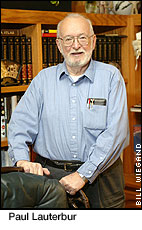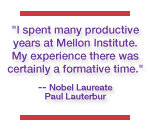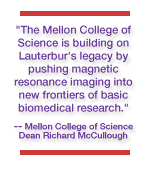|
|
||||
|
|
Former Mellon Institute Researcher Wins Nobel Prize
The Nobel Assembly lauded MRI as a technique that represents a breakthrough in medical diagnosis and research. Today, an estimated 60 million MRI scans are performed annually to visualize the body's internal structures and diagnose a number of ailments, including tumors, stroke damage, heart and brain disease and back problems.
Lauterbur is the Center for Advanced Study Professor of Chemistry at the University of Illinois at Urbana-Illinois, where he holds several senior faculty appointments. He received his bachelor's degree in chemistry from the Case Institute of Technology in 1951 and his doctor's degree in chemistry from the University of Pittsburgh in 1962. After completing his Ph.D., Lauterbur left Pittsburgh for a position at New York University at Stony Brook.
"I spent many productive years at Mellon Institute," said Lauterbur. "My experience there was certainly a formative time." He said that his experience at the Mellon Institute inevitably contributed insights that would later lead him to conceive of MRI. He spent more than a decade at the Mellon Institute, conducting fundamental studies on high-resolution nuclear magnetic resonance (NMR) spectroscopy. NMR defines the chemical structure of compounds by observing the behavior of the nuclei in atoms when they are exposed to a magnetic field and pulses of radio waves. Lauterbur realized that by varying the strength of the magnetic field and analyzing the characteristics of the radio waves being emitted by the nuclei, he could use NMR to create a two-dimensional picture. Mansfield developed a mathematical method to analyze the radio waves emitted by the nuclei, which resulted in a useful imaging technique. These discoveries led to MRI's modern use as a medical imaging tool.
Although he left the Mellon Institute in 1963, Lauterbur's pioneering work in developing MRI has not gone unrecognized by the Carnegie Mellon community. He was awarded an honorary doctor of science degree in 1987 and received the Dickson Prize in 1993. The Dickson Prize honors individuals who make outstanding contributions to the field of science in the United States.
For instance, at the Pittsburgh NMR Center for Biomedical Research, located in the Mellon Institute and jointly sponsored by Carnegie Mellon and the University of Pittsburgh, researchers use powerful magnets and spectrometers to conduct research in the biomedical field. "Any work with MRI done here or anywhere is because of Paul Lauterbur's discoveries," said Chien Ho, director of the center and Alumni Professor of Biological Sciences. Eric Ahrens, a member of the Pittsburgh NMR Center for Biomedical Research and assistant professor of biological sciences, is one of a select group of researchers with the capability to perform magnetic resonance microscopy (MRM), extremely high-resolution MRI. MRM can be used to observe the inner workings of intact living animals in three dimensions at near-cellular resolution. Research performed by both Ho and Ahrens is advancing the understanding of immunity and diseases, including cancer and multiple sclerosis. Even before Lauterbur published what is considered to be his seminal paper establishing the basis of MRI, he said he knew "that another way to look at tissues inside the body was bound to be useful." What he didn't predict was the amazing penetration of MRI into the field of medicine. "This was a very agreeable surprise." � �
Amy Pavlak
|
||
|
Carnegie Mellon Home |
||||
 Paul Lauterbur, a former Mellon Institute researcher, was awarded the 2003 Nobel Prize in Physiology or Medicine on Oct. 6 for his discoveries leading to the development of magnetic resonance imaging (MRI). He received the Nobel Prize jointly with Sir Peter Mansfield of the University of Nottingham in England.
Paul Lauterbur, a former Mellon Institute researcher, was awarded the 2003 Nobel Prize in Physiology or Medicine on Oct. 6 for his discoveries leading to the development of magnetic resonance imaging (MRI). He received the Nobel Prize jointly with Sir Peter Mansfield of the University of Nottingham in England.
 While a graduate student at the University of Pittsburgh, Lauterbur worked as a research associate at the Mellon Institute, which later merged with Carnegie Institute of Technology to become Carnegie Mellon University.
While a graduate student at the University of Pittsburgh, Lauterbur worked as a research associate at the Mellon Institute, which later merged with Carnegie Institute of Technology to become Carnegie Mellon University.
 "We are very happy for Dr. Lauterbur and pleased that his career at the Mellon Institute played a critical role in the development of a technology that is transforming medicine," said Richard McCullough, dean of the
"We are very happy for Dr. Lauterbur and pleased that his career at the Mellon Institute played a critical role in the development of a technology that is transforming medicine," said Richard McCullough, dean of the